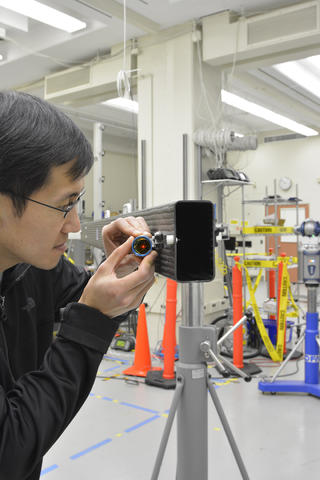
Vincent Lee adjusts the laser target tracker on the prototype length artifact, a hollow carbon-fiber beam approximately 2.5 meters long.
Laser trackers are state-of-the-art measuring machines that are capable of measuring the dimensions of large objects (up to approximately 120 meters in length) to high accuracy and with uncertainties on the order of about 60 µm. Commercially, they are used in large-scale applications such as the precise measurement of size and shape of aircraft wings, an example where accuracy is extremely important due to the significant cost of these high-value added manufactured assemblies. Performance testing of these $180,000 measuring machines is difficult because they have large work-volumes with relatively low measurement uncertainties, requiring long high-accuracy length artifacts.
Historically, users have returned their instruments to the manufacturers periodically so a length calibration can be performed to make sure the instruments are functioning properly. Because these instruments are mobile, the accuracy of the measurements must be checked each time they are used. If you don't check the instrument before a measurement is performed you might not know if the instrument is performing correctly until it is too late.
NIST engineers led by Daniel Sawyer in PML's Semiconductor and Dimensional Measurement Division are collaborating, under a Cooperative Research and Development Agreement (CRADA)1 with Brunson Incorporated, a U.S. manufacturer of metrology equipment, to develop a commercial artifact that can check the calibration of a laser tracker in a way that is both quick and portable. Brunson Incorporated is providing the funding, product design, and manufacturing, and PML is providing the state-of-the-art measurement expertise.
"Our expertise is developing large artifacts for all kinds of measuring instruments, including laser trackers," Sawyer says. "Brunson has expertise in manufacturing high-accuracy fixtures and mounting. Plus they know how to manufacture consumer goods."
"You need large accurate length references," Sawyer says, explaining the process of verifying the accuracy of a laser tracker. "Measuring calibrated length artifacts in the field is a powerful tool to ensure that your instrument is working properly before an inspection of actual parts is performed."
PML and Brunson Incorporated are on track to produce a product that will allow customers to bring the artifact, along with a custom-fitted tripod, to the site of the measurement and check the performance of the laser tracker in as little as 30 minutes. Artifacts of this size, it turns out, are difficult to build: "If they're not carefully designed and constructed, they won't hold their calibrated value during testing," Sawyer explains. "We have a long history, at NIST, of developing artifacts for the large-scale manufacturing community and have advanced the measurement science needed for their construction."2
The prototype artifact is a rigid carbon fiber structure that is kinematically supported to prevent it from losing its calibrated value during the field testing of laser trackers. A laser target is positioned on each end at approximately 2.3 m apart.3 The artifact will be available with a rigid tripod that allows the unit to be held horizontally vertically, and diagonally to perform a comprehensive test of the laser tracker measuring system (per American Society of Mechanical Engineers standard B89.4.19).
"Right now, there is nothing in the industry with the length accuracy of this prototype artifact," Sawyer confirms. If all goes well, Brunson Incorporated anticipates marketing the final product by the summer of 2014.
Looking ahead, Sawyer hopes that this collaboration will ultimately lead to additional artifacts, produced by American companies, that are suitable for checking other types of coordinate measuring systems.
"Ultimately, our long-term goal," Sawyer says, "is to help U.S. manufacturers meet the critical measurement needs of the global large-scale manufacturing industry."

1CRADAs are partnering tools allowing federal laboratories to work with U.S. industries, academia and other organizations on cooperative R&D projects. CRADAs provide flexibility in structuring project contributions, intellectual property rights, and in protecting proprietary information and CRADA research results.
2http://dx.doi.org/10.6028/jres.117.013
3The length of 2.3 meters is the minimum allowed by the American Society of Mechanical Engineers B89.4.19documentary standard, which specifies the way laser trackers are tested.

